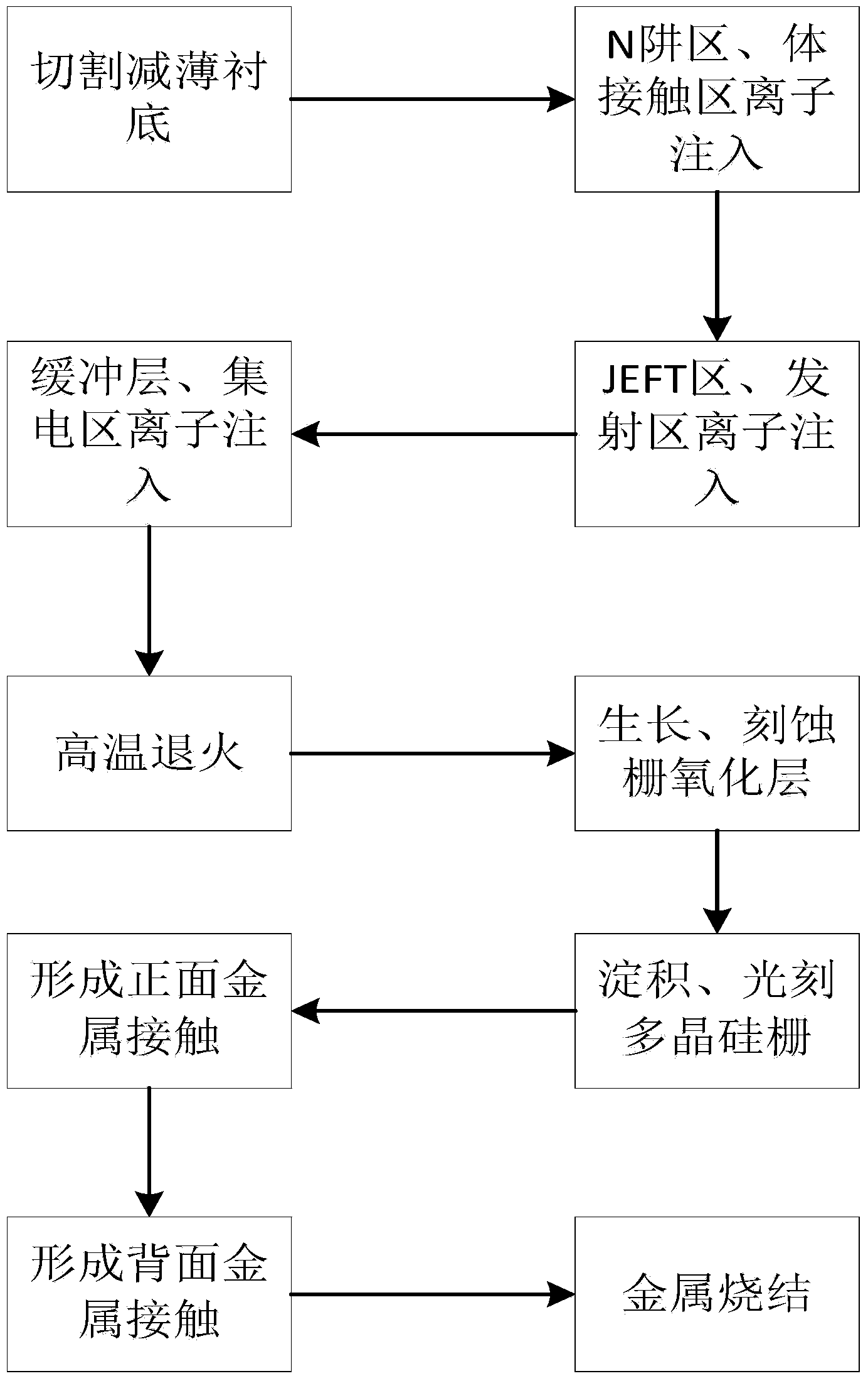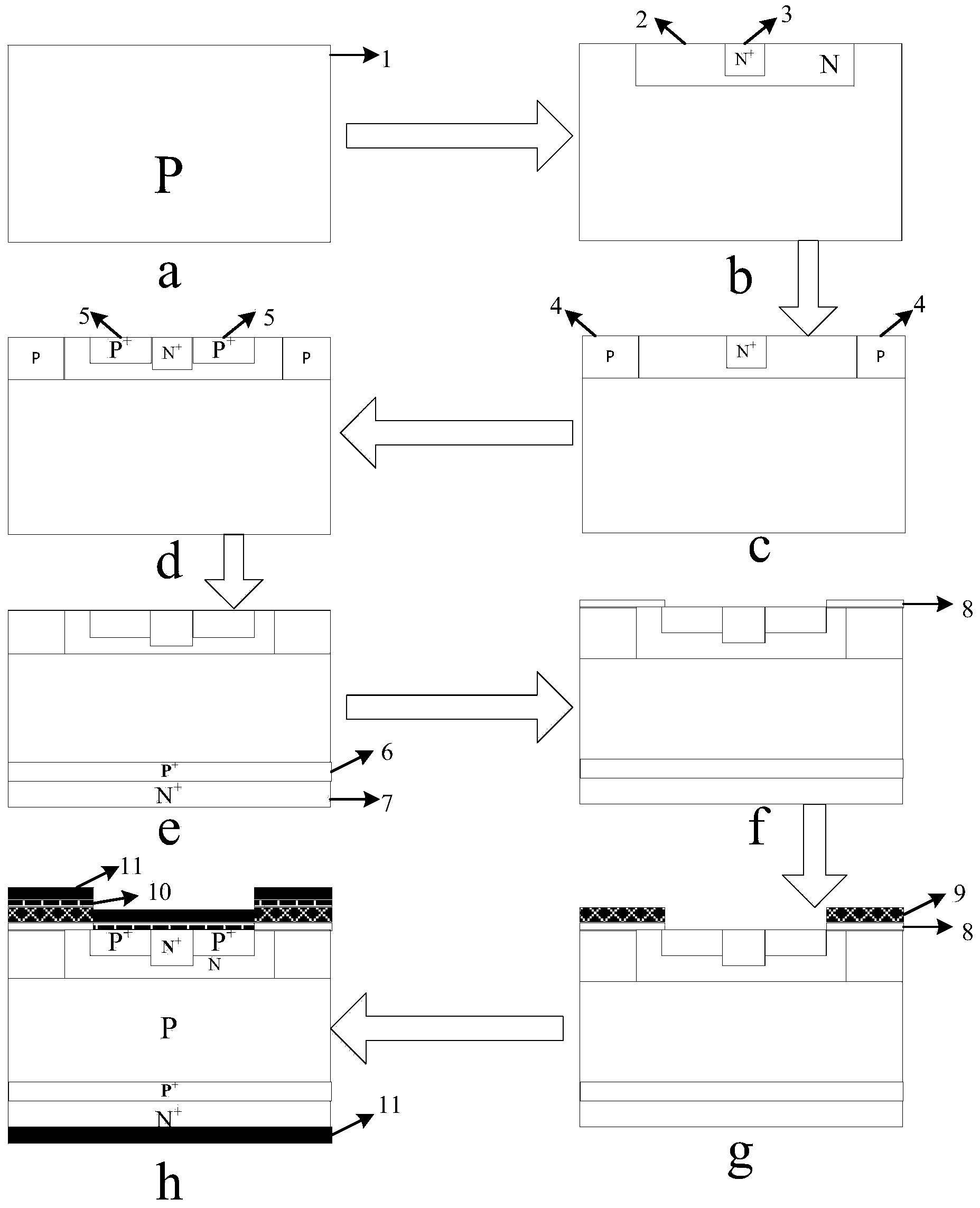Method for preparing punch-through type silicon carbide insulated gate bipolar transistor
A technology of bipolar transistors and general-type silicon carbide, which is applied in the field of microelectronics, can solve the problems of high energy consumption in the epitaxial process, high manufacturing costs, and high process requirements, so as to save manufacturing costs and time, reduce manufacturing difficulty, and save resources. effect with energy
- Summary
- Abstract
- Description
- Claims
- Application Information
AI Technical Summary
Problems solved by technology
Method used
Image
Examples
Embodiment 1
[0030] Example 1: The dislocation in the basal plane is 10 4 / cm -3 , The substrate concentration is 2×10 14 cm -3 The through-type silicon carbide insulated gate bipolar transistor is fabricated on a P-type SiC substrate with no microtube structure.
[0031] Reference figure 1 with figure 2 , The implementation steps of this embodiment are as follows:
[0032] Step 1: Substrate processing.
[0033] Cut along the back side of the P-type SiC substrate 1 and thin it to 100μm, such as figure 2 a; Polish the cut surface, then wet oxygen oxidation at 950℃ for 20 minutes, then remove the oxide layer to restore the structure and flatness of the cut surface.
[0034] Step 2: N-trap ion implantation.
[0035] (2.1) A low-pressure chemical vapor deposition method is used to deposit a layer of SiO with a thickness of 0.2 μm on the front of the P-type SiC substrate 2 , And then deposit Al with a thickness of 1 μm as a barrier layer for nitrogen ion implantation, and photoetch the N-well implant...
Embodiment 2
[0059] Example 2: The dislocation at the base plane is 10 4 / cm -3 , The substrate concentration is 6×10 14 cm -3 The through-type silicon carbide insulated gate bipolar transistor is fabricated on a P-type SiC substrate with no microtube structure.
[0060] Reference figure 1 with figure 2 , The implementation steps of this embodiment are as follows:
[0061] Step A: Same as Step 1 of Example 1.
[0062] Step B: N-well implantation.
[0063] (b1) The same as the step (2.1) of Example 1;
[0064] (b2) Perform two ion implantation on the front side of the P-type SiC substrate at 650℃, that is, first use the implantation energy of 450Kev and 5×10 12 cm -2 The implantation dose of nitrogen ion is implanted once, and the implantation energy of 250Kev, 1×10 12 cm -2 The implantation dose of the second nitrogen ion implantation to form the N well 2, such as figure 2 b.
[0065] Step C: Apply glue on the front surface of the P-type SiC substrate that has completed the above process, and etc...
Embodiment 3
[0079] Example 3: The dislocation at the base plane is 10 4 / cm -3 , The substrate concentration is 1×10 15 cm -3 The through-type silicon carbide insulated gate bipolar transistor is fabricated on a P-type SiC substrate with no microtube structure.
[0080] Reference figure 1 with figure 2 , The implementation steps of this embodiment are as follows:
[0081] Step 1: Same as Step 1 of Example 1.
[0082] Step 2: Use low pressure chemical vapor deposition to deposit a layer of SiO with a thickness of 0.2μm on the front of the P-type SiC substrate 2 , Then deposit Al with a thickness of 1μm as a barrier layer for nitrogen ion implantation, and etch the window of the N-well implantation area by coating photolithography; perform two ion implantation on the front side of the P-type SiC substrate at 650℃, that is, first use 600Kev Energy injection, 8×10 12 cm -2 Nitrogen ion implantation is performed once at the implant dose, and then an implantation energy of 350Kev, 4×10 12 cm -2 The ...
PUM
| Property | Measurement | Unit |
|---|---|---|
| Thickness | aaaaa | aaaaa |
| Deposition thickness | aaaaa | aaaaa |
| Thickness | aaaaa | aaaaa |
Abstract
Description
Claims
Application Information
 Login to View More
Login to View More - R&D Engineer
- R&D Manager
- IP Professional
- Industry Leading Data Capabilities
- Powerful AI technology
- Patent DNA Extraction
Browse by: Latest US Patents, China's latest patents, Technical Efficacy Thesaurus, Application Domain, Technology Topic, Popular Technical Reports.
© 2024 PatSnap. All rights reserved.Legal|Privacy policy|Modern Slavery Act Transparency Statement|Sitemap|About US| Contact US: help@patsnap.com









